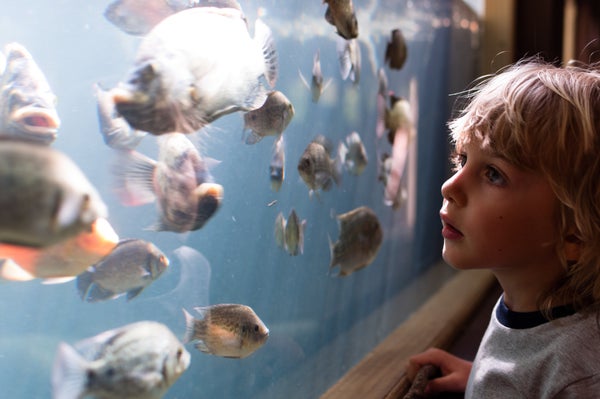This article was published in Scientific American’s former blog network and reflects the views of the author, not necessarily those of Scientific American
It’s not often that toddlers get to meet a movie star, but this weekend packs of small children at the local aquarium got to meet two. Though hardly the biggest or most impressive fish in the room, the clownfish and blue tang were swarmed in their tank by tiny hands and tiptoes. Those kids (and, yes, some of the parents) weren’t just looking at fish, they were getting to meet Nemo and Dory.
There was the initial shock at how small the plucky heroes were, not an unfamiliar experience for any adult who has seen the Mona Lisa, but there was also a clear sense of wonder. Whether for practical or sentimental reasons, an aquarium employee had also placed a cleaner shrimp in the same tank. Patient visitors got to witness the real-life version of the cleaning regimen experienced by the tank-mates in Finding Nemo - admittedly a bit more abrupt and startling than the movie version. Nearby tanks had puffer fish, anemone, and a “coming soon” sign for an octopus. Any doubt about potential coincidence evaporated in the gift shop, filled with versions of Nemo and Dory of varying quality and price point.
Any cynicism about the situation won’t last long amongst the giggles and gaping mouths. While dinosaurs have long been a kid favorite, my generation got a special dose with Jurassic Park and The Land Before Time. Archaeology exhibits are still being filled by the fans of Indiana Jones and Lara Croft. The movies we see and the songs we listen to do shape where we want to look, but the day at the aquarium reminded me that they also affect how long and how deeply we are willing to look once we are there. I certainly did not know as much about sting rays and jelly fish as the preschoolers around me. I could not have told you the difference between coral and an anemone. And I probably also would not have been as patient waiting for an eel to move as the girl in the polka-dotted leggings.
On supporting science journalism
If you're enjoying this article, consider supporting our award-winning journalism by subscribing. By purchasing a subscription you are helping to ensure the future of impactful stories about the discoveries and ideas shaping our world today.
But the kids in the room obviously weren’t the only ones feeling the effects. The vaguely traumatizing portrayal of the touch tanks in Finding Dory left more than me hesitating when reaching for the starfish. I was a bit more insistent about kids being gentle than I might have been before. I spent time noticing the filters. We started wondering about what things looked behind the scenes, if one went “through the pipes.”
Few people seemed to be interested in the section on ocean pollution, despite an interactive activity involving vigorously kicking virtual trash out of a stream. I wondered if that would have been different if our intrepid clownfish had encountered a floating garbage patch or had to rescue a fellow fish from a plastic prison. Obviously, every movie can’t address every idea, but it did trigger flashbacks of FernGully.
But anyone looking for evidence of generational shifts had only to walk through the shark tunnel. Not one person hummed the theme from Jaws. However, the air was littered with references to “baby sharks” and more than a few “doo doo doo doos.” What a difference for one generation to see sharks as a reason to get a bigger boat, and another to call out “fish are friends, not food” and follow it up with a cheerful singalong.
Sitting down and revisiting the world of kids movies has reminded me just how many boxes they can tick. They can handle serious themes, from adoption and memory loss to limb differences. They can make you question placing animals in captivity and start to have opinions about conservation. They can provide nuance to what it means to take risk. And at the end of the day, they will have a huge effect on which parts of the world audiences will decide to take a longer, more careful, and more considerate look.
